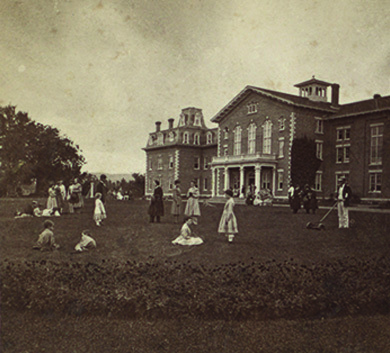| << Chapter < Page | Chapter >> Page > |

The most successful religious utopian community to arise in the antebellum years was begun by Joseph Smith. Smith came from a large Vermont family that had not prospered in the new market economy and moved to the town of Palmyra, in the “burned over district” of western New York. In 1823, Smith claimed to have to been visited by the angel Moroni, who told him the location of a trove of golden plates or tablets. During the late 1820s, Smith translated the writing on the golden plates, and in 1830, he published his finding as The Book of Mormon . That same year, he organized the Church of Christ, the progenitor of the Church of Latter-Day Saints popularly known as Mormons . He presented himself as a prophet and aimed to recapture what he viewed as the purity of the primitive Christian church, purity that had been lost over the centuries. To Smith, this meant restoring male leadership.
Smith emphasized the importance of families being ruled by fathers. His vision of a reinvigorated patriarchy resonated with men and women who had not thrived during the market revolution, and his claims attracted those who hoped for a better future. Smith’s new church placed great stress on work and discipline. He aimed to create a New Jerusalem where the church exercised oversight of its members.
Smith’s claims of translating the golden plates antagonized his neighbors in New York. Difficulties with anti-Mormons led him and his followers to move to Kirtland, Ohio, in 1831. By 1838, as the United States experienced continued economic turbulence following the Panic of 1837, Smith and his followers were facing financial collapse after a series of efforts in banking and money-making ended in disaster. They moved to Missouri, but trouble soon developed there as well, as citizens reacted against the Mormons’ beliefs. Actual fighting broke out in 1838, and the ten thousand or so Mormons removed to Nauvoo, Illinois, where they founded a new center of Mormonism.
By the 1840s, Nauvoo boasted a population of thirty thousand, making it the largest utopian community in the United States. Thanks to some important conversions to Mormonism among powerful citizens in Illinois, the Mormons had virtual autonomy in Nauvoo, which they used to create the largest armed force in the state. Smith also received further revelations there, including one that allowed male church leaders to practice polygamy. He also declared that all of North and South America would be the new Zion and announced that he would run for president in the 1844 election.
Smith and the Mormons’ convictions and practices generated a great deal of opposition from neighbors in surrounding towns. Smith was arrested for treason (for destroying the printing press of a newspaper that criticized Mormonism), and while he was in prison, an anti-Mormon mob stormed into his cell and killed him. Brigham Young ( [link] ) then assumed leadership of the group, which he led to a permanent home in what is now Salt Lake City, Utah.

Notification Switch
Would you like to follow the 'U.s. history' conversation and receive update notifications?